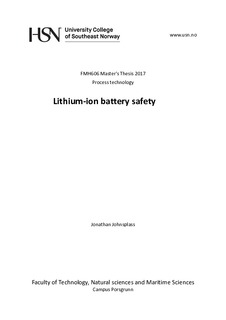| dc.description.abstract | The aim of this thesis was two folded: Numerically compute the combustion properties of the discharge materials from lithium-ion batteries, and experimentally measure the properties, at a test rig, by overheating lithium-ion batteries and igniting the vented mixture, and using a high-speed camera, pressure sensor and temperature senor to capture, and measure the flame propagation.
The combustion properties targeted to determine were: The laminar burning velocity, the flame speed, the deflagration index, the volumetric expansion ratio at constant pressure combustion and the overpressure at constant volume combustion.
Additionally, to numerically compute the combustion properties, the aim was to determine the input properties: the NASA polynomials and the Gulder coefficients of the vented gas mixture to enable CFD studies in OpenFOAM with the premixed turbulent solver XiFoam of the vented mixture from overheated lithium-ion batteries, and to validate the input values in XiFoam by a simple case study of a flame propagation.
The computations of the laminar-combustion properties, i.e. deflagration index, laminar burning velocity, the volumetric expansion ratio at constant pressure combustion and the overpressure at constant volume combustion were programmed in the open source chemical kinetics software Cantera 2.3.0. The computations have been based primarily on two chemical mechanisms: GRI-Mech 3.0 and the DMC-Mech. The composition of the discharge materials was based on the Golubkov et al. study Thermal-runaway experiments on consumer Li-ion batteries with metal-oxide and olivine-type cathodes. The study analysed the vented mixture from three 18650 overheated lithium batteries named after their cathode-chemistry: a lithium cobalt oxide battery, a lithium iron phosphate battery and a lithium nickel manganese cobalt oxide battery.
To determine the XiFoam input values the NASA polynomials, and the Gulder coefficients it was necessary to compute the laminar burning velocity as a function of initial temperature, pressure and equivalence ratio, and the thermodynamical data enthalpy, entropy, and heat capacity for the premixed fuel-air mixture in Cantera 2.3.0 and to curve fit the computed datasets, in Cantera, with the optimization software LMFIT to the NASA function, and Gulder function.
The experimental measurements were based on two overheated lithium manganese dioxide batteries, and a methane-air mixture. The flame speed was determined by tracking the flame front position with respect to time, and curve fit the position data to a sextic polynomial expression with the LMFIT software. The sextic polynomial was then derivated with respect to time. The derivative expression, i.e. the quintic polynomial was due to this method an approximate for the flame speed. This method was based on the statistical technique referred to as smoothing.
The numerically computations of the laminar-combustion properties indicated that the vented lithium-ion battery gas have similar combustion properties as the two common hazardous gases methane and propane. The electrolyte solvent component dimethyl carbonate had an equal deflagration index as the vented battery gas from the lithium cobalt oxide battery, which was higher than the deflagration index of the lithium iron phosphate battery and the lithium nickel manganese cobalt oxide battery.
The Gulder coefficients and the NASA polynomials were implemented, and tested in OpenFOAM with XiFoam. The test indicated that additional tests are necessary to determine if the NASA coefficients and Gulder coefficients needs to be further adjusted.
The experimental measurement from the test rig of the lithium manganese dioxide battery indicated that the vented gas propagates approximately with the same flame speed as methane, however further tests are necessary to validate this. | nb_NO |
